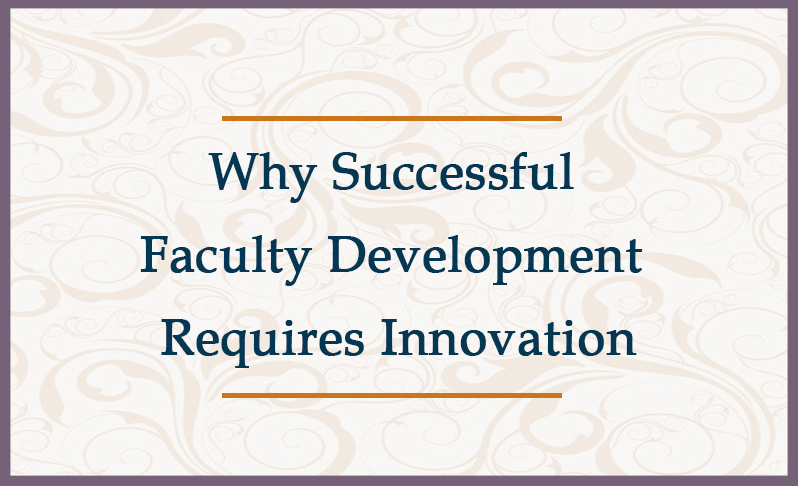Is the term “innovative faculty development” actually redundant? In our way of thinking, faculty development—mostly because of its youth—necessitates innovation. In fact, any new field depends upon creative thinking and its implementation into innovation to progress.
In our academic careers, despite a background in traditional studies in English, we have helped develop three new disciplines—pop culture (especially comic book theory), creative writing, and now faculty development. Our careers have coincided with the rise of these three fields as they, like us, got their start in the 1960s.
But here we want to focus on faculty development. While the more formal structure we think of as faculty development began around 50 years ago, way back in 1810 Harvard University granted its first sabbatical, and many claim that action as the first instance of faculty development. In Creating the Future of Faculty Development (2006), Sorcinelli et al posit that faculty development has evolved through five ages:
- The Age of the Scholar (1960s-mid 70s)
- The Age of the Teacher (mid-to-late 70s)
- The Age of the Developer (1980s)
- The Age of the Learner (1990s), and
- The Age of the Network (21st century).
Obviously such constant change necessitates innovation.
Factors That Make Faculty Development Respectable and Acceptable
In his “Afterword” to the second edition of Gillespie and Robertson’s A Guide to Faculty Development (2010), William Bergquist describes this fifty-year growth as “The Diffusion of Faculty Development as an Innovation” (406). Bergquist also identifies four factors that have made faculty development “respectable and acceptable on college and university campuses”:
- “building a base of research evidence and interdisciplinary scholarship”
- “constructing solid administrative support”
- “building upon newly emerging institutional norms and values” and
- “establishing a profession to guide the further development of the field” (409).
In short, the basic nature of a new field is change, and through innovation faculty development has sustained its progress. Interestingly, the Subject Index to Gillespie and Robertson’s book contains no heading for either “Innovation” or “Creative Thinking” as the assumption seems to be that these two concepts have provided the field’s firm foundation for fifty years.
Innovation Helps Faculty Respond to Changing Realities
Innovation will continue to undergird the maturation of faculty development because of the constant changing of higher education itself. Several forces are causing centers for teaching and learning (CTLs) to adapt. In fact, the term CTL is a bit misleading as every CTL we know is slightly different in terms of size, budget, composition, reporting responsibility, and mission. In our own short fifteen year history, for example, we have gone from a pure faculty-facing unit, lost our control of the university’s IT division, and recently merged with a student-facing studio for academic creativity. Innovate or perish has been our unofficial motto.
Change abounds for all CTLs. Due to the spiraling cost of higher education, many centers have been closed/funding has been cut. Other forces providing challenges have been identified by Gillespie and Robertson’s book by Lee:
- Sophistication of learning technologies
- Diversification and globalization of the student body
- Ascendance of assessment
- Networking (Sorcinelli’s term)—i.e., being asked to partner with internal and external units
- “Adjuncting” of CTL clientele: many institutions report over half of the professorate is part-time (30)
- Additional responsibilities.
Let’s investigate the last item on the list. We often joke that the “L” in TLC (the Teaching & Learning Center) actually stands for “landfill.” Each year we are “asked” to take on additional work (and, no, the budget never seems to increase). For instance, while we have always been in charge of New Faculty Orientation, recently we have picked up Part-Time Orientation and T.A. Training. This year we added the training of instructors in the First-Year Courses program. When the Provost’s Professional Development Series (i.e., putting on a major workshop such as Dee Fink’s Creating Significant Learning Experiences) was instituted two years ago), we made the arrangements.
Faculty development also has to respond to changing realities. For instance, faculty across the country are being asked to do more, while simultaneously research shows that new faculty treat professing less as a calling and more as a 9:00 to 5:00 job. As a CTL, we are still tasked with developing these time-taxed professionals, but how do we do it? Certainly, the traditional lunch-and-learn session has lost its luster. That sounds like a post for next time.
Author
 Dr. Russell Carpenter is director of the Noel Studio for Academic Creativity and Program Director of the Minor in Applied Creative Thinking at Eastern Kentucky University. He is also Assistant Professor of English. Dr. Carpenter has published on the topic of creative thinking, among other areas, including two texts by New Forums Press. In addition, he has taught courses in creative thinking in EKU’s Minor in Applied Creative Thinking, which was featured in the New York Times in February 2014. Meet Russell.
Dr. Russell Carpenter is director of the Noel Studio for Academic Creativity and Program Director of the Minor in Applied Creative Thinking at Eastern Kentucky University. He is also Assistant Professor of English. Dr. Carpenter has published on the topic of creative thinking, among other areas, including two texts by New Forums Press. In addition, he has taught courses in creative thinking in EKU’s Minor in Applied Creative Thinking, which was featured in the New York Times in February 2014. Meet Russell.



